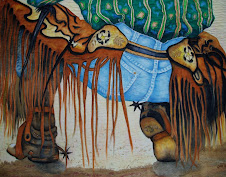A day after blocking as discussed in yesterday's post, I am ready to square up this quilted piece. So the rest of this post makes sense, let me first give you a description of my overall approach. The blocked flat quilt is marked, stay stitched on the marked line, and then cut just to the outside edge of the marking.
First, the measuring and marking. I evaluate which side is most important to mark first and do that. I am using a frixion pen that I can see well.
1) In this example I chose the bottom of the quilt as the entire bottom portion is a view of a street that meets up a few inches away from a stoop on which my subjects are sitting. It seems important that the distance between the bottom of a stoop/step... and the shown street edge be the same... thus I began there. I'm using a big T-square to do this marking. Really helps.
2) Before I mark the opposite side (in this first effort, the top edge), I measure ( I like a metal carpenter tape for this as it is rigid and can be locked in position) at least 3 times from bottom to top and lightly mark spots where I wish to draw the long line. The line gets drawn all the way across the top.
3) On one side of the quilt, I determine where I might want to crop the edges and then mark a vertical top to bottom line making certain they are right angles at each intersection of top and bottom lines.
4) Use a similar process used in step 2) for the opposite side of the quilt. Once all 4 sides are marked, it's time to move on.
In the following steps I am using my regular 1/4 inch foot to run a stay stitch right atop the marked lines. To do this, I must first reduce the pressure the foot places on the now quilted piece. I lower the pressure 'til the quilt can be fed ( with feed dogs up) without stretching out the blocking we did on yesterdays post. I suppose one could use a quilting foot on this too... I just prefer this method as I can see much better with a simple pressure foot. I stitch all the way around the quilt atop the line.
In this case, I used monofilament thread so you can't see it at all... but it is there.
Next up, I rotary cut a clean edge just to the outside of the marked line. The cutaway excess becomes scrap.
The quilt remains nice and flat and we are trimmed up, ready to either bind or face. I like to face most pictorial pieces. I show that next up.
Don't be worrying about this blue marking. It will disappear in the next effort.
Thursday, October 11, 2012
Subscribe to:
Post Comments (Atom)










No comments:
Post a Comment